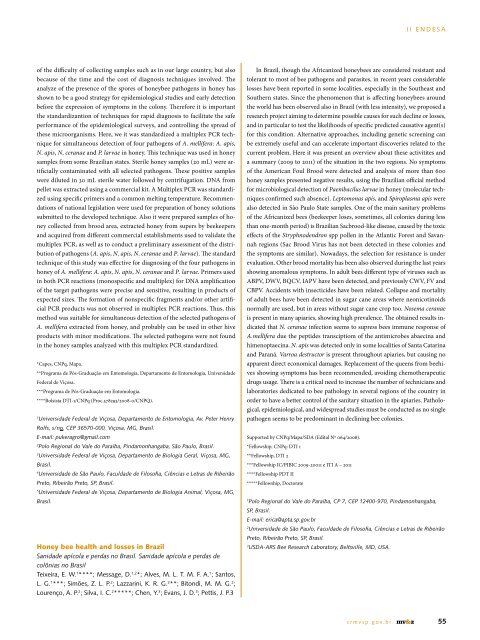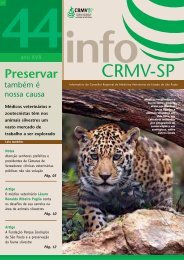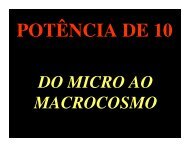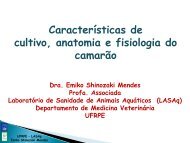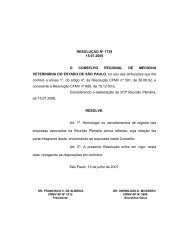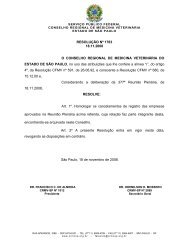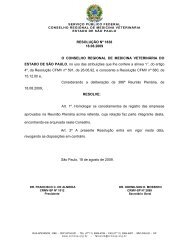Create successful ePaper yourself
Turn your PDF publications into a flip-book with our unique Google optimized e-Paper software.
I I e n d e s aof the difficulty of collecting samples such as in our large country, but alsobecause of the time and the cost of diagnosis techniques involved. Theanalyze of the presence of the spores of honeybee pathogens in honey hasshown to be a good strategy for epidemiological studies and early detectionbefore the expression of symptoms in the colony. Therefore it is importantthe standardizantion of techniques for rapid diagnosis to facilitate the safeperformance of the epidemiological surveys, and controlling the spread ofthese microorganisms. Here, we it was standardized a multiplex PCR techniquefor simultaneous detection of four pathogens of A. mellifera: A. apis,N. apis, N. ceranae and P. larvae in honey. This technique was used in honeysamples from some Brazilian states. Sterile honey samples (20 mL) were artificiallycontaminated with all selected pathogens. These positive sampleswere diluted in 30 mL sterile water followed by centrifugation. DNA frompellet was extracted using a commercial kit. A Multiplex PCR was standardizedusing specific primers and a common melting temperature. Recommendationsof national legislation were used for preparation of honey solutionssubmitted to the developed technique. Also it were prepared samples of honeycollected from brood area, extracted honey from supers by beekeepersand acquired from different commercial establishments used to validate themultiplex PCR, as well as to conduct a preliminary assessment of the distributionof pathogens (A. apis, N. apis, N. ceranae and P. larvae). The standardtechnique of this study was effective for diagnosing of the four pathogens inhoney of A. mellifera: A. apis, N. apis, N. ceranae and P. larvae. Primers usedin both PCR reactions (monospecific and multiplex) for DNA amplificationof the target pathogens were precise and sensitive, resulting in products ofexpected sizes. The formation of nonspecific fragments and/or other artificialPCR products was not observed in multiplex PCR reactions. Thus, thismethod was suitable for simultaneous detection of the selected pathogens ofA. mellifera extracted from honey, and probably can be used in other hiveproducts with minor modifications. The selected pathogens were not foundin the honey samples analyzed with this multiplex PCR standardized.*Capes, CNPq, Mapa.**Programa de Pós-Graduação em Entomologia, Departamento de Entomologia, UniversidadeFederal de Viçosa.***Programa de Pós-Graduação em Entomologia.****Bolsista DTI-1/CNPq (Proc.578293/2008-0/CNPQ).1Universidade Federal de Viçosa, Departamento de Entomologia, Av. Peter HenryRolfs, s/no, CEP 36570-000, Viçosa, MG, Brasil.E-mail: pukeragro@gmail.com2Polo Regional do Vale do Paraíba, Pindamonhangaba, São Paulo, Brasil.3Universidade Federal de Viçosa, Departamento de Biologia Geral, Viçosa, MG,Brasil.4Universidade de São Paulo, Faculdade de Filosofia, Ciências e Letras de RibeirãoPreto, Ribeirão Preto, SP, Brasil.5Universidade Federal de Viçosa, Departamento de Biologia Animal, Viçosa, MG,Brasil.Honey bee health and losses in BrazilSanidade apícola e perdas no Brasil. Sanidade apícola e perdas decolônias no BrasilTeixeira, E. W. 1 ****; Message, D. 1,2 *; Alves, M. L. T. M. F. A. 1 ; Santos,L. G. 1 ***; Simões, Z. L. P. 2 ; Lazzarini, K. R. G. 2 **; Bitondi, M. M. G. 2 ;Lourenço, A. P. 2 ; Silva, I. C. 2 *****; Chen, Y. 3 ; Evans, J. D. 3 ; Pettis, J. P.3In Brazil, though the Africanized honeybees are considered resistant andtolerant to most of bee pathogens and parasites, in recent years considerablelosses have been reported in some localities, especially in the Southeast andSouthern states. Since the phenomenon that is affecting honeybees aroundthe world has been observed also in Brazil (with less intensity), we proposed aresearch project aiming to determine possible causes for such decline or losses,and in particular to test the likelihoods of specific predicted causative agent(s)for this condition. Alternative approaches, including genetic screening canbe extremely useful and can accelerate important discoveries related to thecurrent problem. Here it was present an overview about these activitites anda summary (2009 to 2011) of the situation in the two regions. No symptomsof the American Foul Brood were detected and analysis of more than 600honey samples presented negative results, using the Brazilian official methodfor microbiological detection of Paenibacilus larvae in honey (molecular techniquesconfirmed such absence). Leptomonas apis, and Spiroplasma apis werealso detected in São Paulo State samples. One of the main sanitary problemsof the Africanized bees (beekeeper loses, sometimes, all colonies during lessthan one-month period) is Brazilian Sacbrood-like disease, caused by the toxiceffects of the Stryphnodendron spp pollen in the Atlantic Forest and Savannahregions (Sac Brood Virus has not been detected in these colonies andthe symptoms are similar). Nowadays, the selection for resistance is underevaluation. Other brood mortality has been also observed during the last yearsshowing anomalous symptoms. In adult bees different type of viruses such asABPV, DWV, BQCV, IAPV have been detected, and previously CWV, FV andCBPV. Accidents with insecticides have been related. Collapse and mortalityof adult bees have been detected in sugar cane areas where neonicotinoidsnormally are used, but in areas without sugar cane crop too. Nosema ceranaeis present in many apiaries, showing high prevalence. The obtained results indicatedthat N. ceranae infection seems to supress bees immune response ofA.mellifera due the peptides transciptiom of the antimicrobes abaecina andhimenoptaecina. N. apis was detected only in some localities of Santa Catarinaand Paraná. Varroa destructor is present throughout apiaries, but causing noapparent direct economical damages. Replacement of the queens from beehivesshowing symptoms has been recom mended, avoiding chemotherapeuticdrugs usage. There is a critical need to increase the number of technicians andlaboratories dedicated to bee pathology in several regions of the country inorder to have a better control of the sanitary situation in the apiaries. Pathological,epidemiological, and widespread studies must be conducted as no singlepathogen seems to be predominant in declining bee colonies.Supported by CNPq/Mapa/SDA (Edital Nº 064/2008).*Fellowship, CNPq: DTI 1**Fellowship, DTI 2***Fellowship IC/PIBIC 2009-20011 e ITI A – 2011****Fellowship PDT II*****Fellowship, Doctorate1Polo Regional do Vale do Paraíba, CP 7, CEP 12400-970, Pindamonhangaba,SP, Brasil.E-mail: erica@apta.sp.gov.br2Universidade de São Paulo, Faculdade de Filosofia, Ciências e Letras de RibeirãoPreto, Ribeirão Preto, SP, Brasil.3USDA-ARS Bee Research Laboratory, Beltsville, MD, USA.c r m v s p . g o v . b rmv&z55


